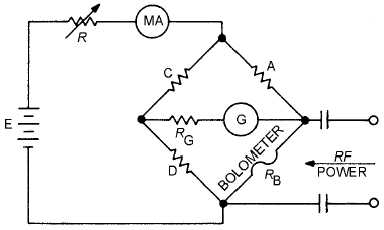3-18
Q-13.
What is the advantage of using in-line wattmeters over output power meters?
Bolometer
A bolometer features a specially constructed element of temperature-sensitive material. The active
material is a semiconductor bead supported between two pigtail leads. When rf power is applied to a
bolometer element, the power absorption by the element heats the element and causes a change in its
electrical resistance. Thus, a bolometer can be used in a bridge circuit so that small resistance changes can
be easily detected and power measurement can be accomplished by the substitution method (that is,
substitution of dc or low-frequency power to produce an equivalent heating effect). A D'Arsonval meter
movement is usually employed as the null indicator.
According to one principle of measurement (the principle used in the balanced bridge), the bridge is
initially balanced with low-frequency bias power. Rf power is then applied to the bolometer and the bias
power is gradually removed until the bridge is again balanced. The actual rf power is then equal to the
bias power removed.
According to another principle of measurement (the principle used in the unbalanced bridge), the
bridge is not rebalanced after the rf power is applied. Rather, the indicator reading is converted directly
into power by calibration previously performed.
Figure 3-16 illustrates the basic bolometer bridge circuit. The bolometer element must be physically
small to be highly sensitive; it must be equally responsive to low-frequency and rf power; and it must be
matched to the rf-input power line. The cross-sectional dimension of the bolometer element is
approximately equal to the skin depth of rf current penetration at the highest frequency of operation. This
condition permits the dc and rf resistivities to be essentially equal with the reactive component of the
bolometer impedance at a minimum. Thermistors, which are a type of bolometer, use semiconductor
material shaped like a bead, with a thicker skin depth and shorter length to minimize standing-wave
effects. These physical properties assure correspondence between lengthwise low-frequency and rf power
distribution to provide the necessary inherent accuracy of the bolometer.
Figure 3-16.—Basic bolometer bridge circuit.
An air-mounted bolometer provides a power sensitivity 100 or more times greater than that provided
by static calorimetric devices. Additional sensitivity may be obtained by mounting the element within an
evacuated envelope to eliminate convective heat loss. The small size of bolometer elements is associated
with small thermal mass and short thermal time constants. The thermal time constant varies directly with
the volume-to-area ratio of the element for a particular shape and composition. Typical time is up to 0.1


